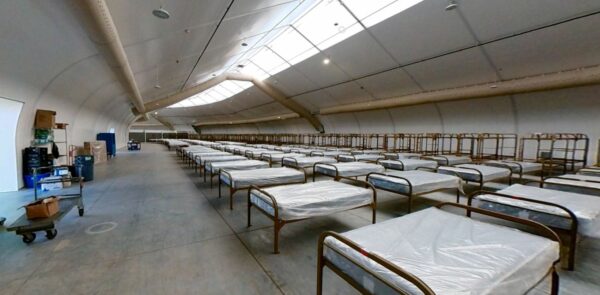
Anchorage Mayor Dave Bronson has proposed building a new, mass homeless shelter by fall.
It would be Anchorage’s first city-owned homeless shelter and house up to 450 people in semi-permanent, domed, tent-like structures. It would also include a “navigation center,” aimed at providing services to people experiencing homelessness and getting them into long-term housing.
RELATED: Here’s what we know about the new Anchorage mayor’s plan for a massive homeless shelter
The Bronson administration points to examples of shelters in cities like San Francisco and Reno, so the Anchorage Daily News sent reporter Michelle Theriault Boots and photographer Marc Lester to see for themselves.
Theriault Boots told Alaska Public Media’s Casey Grove they found potential lessons for Anchorage’s new mayoral administration, especially in Reno.
Listen here:
[Sign up for Alaska Public Media’s daily newsletter to get our top stories delivered to your inbox.]
The following transcript was lightly edited for clarity.
Michelle Theriault Boots: Reno has a lot of parallels to Anchorage both in size and some of the dynamics of its issues with homelessness. They had a lot of large encampments along their rivers.
When the pandemic began, it became very clear that their existing traditional shelter could not house people the way they needed to be housed during a global pandemic. The city joined forces with the county and their neighboring city of Sparks, and used a bunch of money from the CARES Act to very quickly conceive of and build this mass shelter that is built for up to, I think, 604 people.
When we visited at the end of June, it had been open for just about a month.
The scale of it was staggering. You walk in and you see this sea of cots. But it also seemed calm, it seemed peaceful. The people we spoke to at random who were staying there — we weren’t guided to them by management at all, we just approached random people — they also described it as a respite from the challenges of living on the streets, they were appreciative of the showers they could take, they were appreciative of being able to store their things. Most of all, they were appreciative of the security of feeling like people weren’t going to steal their things or hurt them.
There were definitely some negatives. There’s a group of activists in Reno that’s really upset with the city for clearing the outside encampments — now that there’s a shelter, the city has resumed clearing or tearing down encampments, especially along the Truckee River.
Also, outside the shelter there, a new encampment had grown right outside the gate. So you had this quarter of a block of tents on the sidewalk that was people who didn’t want to sleep inside the shelter for their own reasons, but wanted to be in proximity to it, in order to avail themselves of some of those services. So, the city was clearly trying to figure out what to do about that.
Casey Grove: Were there specific things that you learned that might be lessons that the new administration might consider here in Anchorage?
Theriault Boots: The impression that I came away with is that a mass shelter on the scale of Reno can work — it can successfully house people, give them relief from the streets, start to help them solve the longer-term issues they’re facing — but it’s going to take a lot of resources, it’s going to take a lot of money, and it’s going to take a lot of social workers, security and medical services to truly make that something more than just warehousing people.
The managers in Reno also said there were things they didn’t think of as they were building the facility and designing the facility that they wished they would have. I mean, they opened without something as simple as laundry services on site, and that’s caused them a lot of problems. They opened without sufficient space for caseworkers to privately sit with people and help them apply for housing or get a new ID. That’s also caused problems.
The management in Reno told us to really take some time to truly think out how you’re going to structure this, which is something Anchorage doesn’t have. Anchorage has an incredibly tight timeline to do this, if we’re truly going to decommission the Sullivan Arena in the fall and have this new mass navigation center stood up before it gets cold, and sheltering our unhoused population becomes a matter of life and death.
Grove: You’ve got to just build the building, but it’s still yet to be seen how social service workers are going to interact with the homeless population, and whether illegal camps are gonna get taken down by the Bronson administration.
Theriault Boots: One really interesting thing that was happening in Reno was outside of the shelter. We knew that not everybody wanted to stay at the shelter. And so we kind of went walking around, talking to and looking for folks who are continuing to live on the street, and we found some. Everybody had their own reasons. For some, it was just too much to be in a room with hundreds of other people. One or two people mentioned, ‘Oh, there’s some there’s a guy who doesn’t like me that I think is staying there’ — they all have their reasons.
Reno understands that, and so they are offering another opportunity of sanctioned camping. So they have a nonprofit that has set up an outdoor sanctioned camping site where they will provide a tent. Everybody gets their own individual tent. It’s outdoors, there’s a bathroom. There’s a covered eating area. There is security to get in and out of the site. But beyond that, you’re kind of on your own.
That sanctioned camping idea is an interesting bridge between fully being on the street, maybe illegally camping somewhere you’re not supposed to camp, and wanting to stay inside a mass shelter with hundreds of other people.
I know other cities have explored that sanctioned camping approach, and I’m curious to know if that’s something Anchorage will pursue. I’m not sure about that.
Casey Grove is host of Alaska News Nightly, a general assignment reporter and an editor at Alaska Public Media. Reach him at cgrove@alaskapublic.org. Read more about Casey here.





